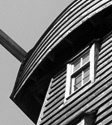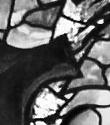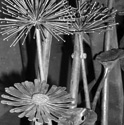 |
 |

Subject: The Branches of Immortality
Journal: The Financial Times Weekend Date: August 1998 Author: Clive Fewins
There is an ancient and mighty yew tree in a barely perceptible spot near the River Thames that has a reputation for disappearing whenever anyone makes a journey to find it. I am convinced the Ankerwyke Yew spirited itself away on the first two occasions I tried.
The third time I ventured to the outer fringes of west London in search of it, I was able, with the help of a local, to pay homage to the tree.
It is reputed to be 4,000 years old and a place of ancient assembly and decision–making, where oaths were sworn and chieftains crowned. Some believe King John met the barons there for preliminary talks before signing Magna Carta.
 The mighty Ankerwyke Yew
Doubtless the next time I visit it will, like the mist, have gone again. But perhaps I should not be surprised – after all, the species is imbued with the qualities of immortality.
But, just in case it should disappear for good, this is one of 30 monster specimens from which cuttings have been taken to be planted in churchyards throughout Britain. (The last battle to prevent the widening of the all–too–near M25, London’s orbital road, at this stretch was won, but what else might come along and light a fire in its hollow centre?)
If this outside assistance seems odd, it is because yews are reputed to be the only known species capable of constant regeneration, making them, in effect, immortal.
What often appears to be a hollow, decaying wreck of a tree may actually be planning its survival. Undetected by man, it might be sinking an aerial root from within the hollow trunk.
To help me ponder this paradox I turned to author, broadcaster and conservationist David Bellamy, who, after battling for much of his 64 years to save rare specimens and species on five continents, is himself regarded by some as having the gift of everlasting life.
He assured me that mortality was taking its toll on his 6ft 2in, 16–stone frame far more than it was on the UK’s stock of yews.
Nevertheless, although the theory is that yews cannot die, and they can regenerate, they will not survive if their roots are ripped from the earth, as Bellamy believes they were until quite recently by farmers who wanted to protect their animals from the trees’ highly toxic foliage and berries.
As a result, he and his associates are running a cutting and propagation programme, using 30 ancient yews as stock.
Apart from this assistance, Britain’s ancient yews have received a great deal of help over many years from Allen Meredith, an ardent conservationist. He has championed their cause since a series of dreams in the mid–1970s told him that he was to devote his life to the yews.
Meredith, now in his mid–40s, took so long to produce the definitive work on the tree that had haunted him for so many years, that other authors wrote a book about his work instead. We are still awaiting Meredith’s magnum opus, and in the meantime he is even harder to track down than the Ankerwyke Yew.
Although he travels the country constantly, visiting thousands of churchyards, checking records that sometimes go back several hundred years to determine if the trees have disappeared or not, Meredith is rarely seen.
On the one occasion I spoke to him – he telephoned me on Christmas day four years ago – he complained that the yews were getting the better of him and he had seriously thought of giving up.
His sense of unease, he said, might be because the yews thought he had discovered their secret – that they pre–date man, who, he believes, grew from the yews – the trees having provided him with food, shelter and medicine.
We all need, he said, to rediscover the secrets of the yew, which he believes to be the Tree of Life, the first tree on earth, pre–dating humans by millions of years and from which we are all descended.
Since then, I have only been able to make occasional contact with him, by letter, through an intermediary.
Occasionally, when I find myself standing beside a giant yew in an ancient churchyard trying to separate fact from fiction in the world of the yews, I half expect him to appear and then to disappear, perhaps inside the tree. Bellamy describes him as “the man who has almost become a yew tree”.
In the meantime, the yews, young and old, stand among the gravestones. They are potent symbols of death, with their poisonous leaves and the supple branches that produced the great longbows that wreaked such deadly havoc at the battle of Agincourt.
Yet their evergreen quality, coupled with their regenerative powers, can be seen as symbolising life. In their churchyard settings it would be hard to find a more potent symbol of the Christian doctrine of the Resurrection.
There are those who believe this is to put things in the wrong order: that the doctrine of the Resurrection is, in part, based on pagan beliefs that were derived from the worship of the yew.
They believe the early Christians took over the sacred groves of our Celtic forefathers, who worshipped the yews for their quality of regeneration, putting down aerial roots to form groves. The groves, it is said, were their cathedrals, and Stonehenge was modelled on them.
In recent years, through the extraction of the juice from soft, young sappy yew shoots, which are processed into a drug called Taxol, yews have provided another form of life–force – a source of relief to sufferers of certain forms of cancer. This is another quality that Allen Meredith believes the druids knew all about.
When he telephoned me, Meredith said he would rather be a yew tree than a human wrestling with the mysteries posed by the species. He was depressed, he said, because he had, at one point, believed he could turn himself into a yew tree.
He failed, which was a shame really. It might have given him a head start in the race to discover the secrets concealed by the species. I don’t know if he feels better now. In a letter I received from him last summer, he seemed to be battling on. I hope he still is.
I can’t help thinking that yews will outlive man in the end. They have, after all, many more years’ experience on their side.
It might be wise, in the meantime, for Bellamy and his helpers to continue with their cutting and propagation work – just in case all the old yews decide one night to up sticks and disappear for a while. Not for long. Just a few thousand years.
|
|||||||
| © 2006–2025 Clive Fewins. All rights reserved. | Site designed by Ridgedale Communications Ltd. | |||||||||||||||||||||






